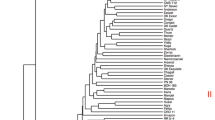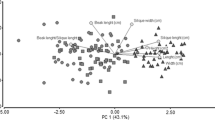Abstract
We investigated introgression in a mixed weedy population ofoilseed rape (Brassica napus) and itsrelative B. rapa usingspecies-specific AFLP-markers. The population wassituated in a field relayed from conventional to organic cultivation11 years ago. One-hundred-and-twoB. napus orB. rapa-like plantswere collected in a 3 m2 plot. Of these, onewas a first generation hybrid (F1) and nearlyhalf (44 plants) were introgressed, having bothB. napus andB. rapa specific markers.The remaining plants apparently corresponded to pure species, with 50having only B. rapa-and seven having only B.napus-specific markers. We compared thenumber of markers in the plants from the weedy population with thenumbers in controlled backcross generations (BC1 andBC2). The marker distribution in the weedy populationresembled the distribution in the second backcross generation mostclosely. Together with the cultivation history of the field, thissuggests that the introgression process in the weedy mixed populationhas been in progress for some time. This study is the first to showintrogression between B.napus and B.rapa under natural conditions.
Similar content being viewed by others
References
Edwards K., Johnstone C. and Thompson C. 1991. A simple and rapid method for the preparation of plant genomic DNA for PCR analysis. Nucl. Acids Res. 19: 1349–1349.
Hauser T.P., Jørgensen R.B. and Østergård H. 1997. Preferential exclusion of hybrids in mixed pollinations between oilseed rape (Brassica napus) and weedy B. campestris (Brassicaceae). Am. J. Bot. 84: 756–762.
Hauser T.P., Shaw R.G. and Østergård H. 1998a. Fitness of F1 hybrids between weedy Brassica rapa and oilseed rape (B.napus). Heredity 81: 429–435.
Hauser T.P., Jørgensen R.B. and Østergård H. 1998b. Fitness of backcross and F2 hybrids between weedy Brassica rapa and oilseed rape (B. napus). Heredity 81: 436–443.
Jørgensen R.B. and Andersen B. 1994. Spontaneous hybridization between oilseed rape (Brassica napus) and weedy B. campestris (Brassicaceae): A risk of growing genetically modified oilseed rape. Am. J. Bot. 81: 1620–1626.
Jørgensen R.B., Andersen B., Hauser T.P., Landbo L., Mikkelsen T.R. and Østergård H. 1998. Introgression of crop genes from oilseed rape (Brassica napus) to related wild species-an avenue for the escape of engineered genes. Acta Hort. 459: 211–217.
Landbo L. 1997. Introgression from oilseed rape (Brassica napus) to weedy Brassica campestris-an avenue for the escape of transgenes?, phd. Risø National Laboratory, Denmark.
Landbo L., Andersen B. and Jørgensen R.B. 1996. Natural hybridization between oilseed rape and a wild relative; hybrids among seeds from weedy B. campestris. Hereditas 125: 89–91.
Landbo L. and Jørgensen R.B. 1997. Seed germination in weedy Brassica campestris and its hybrids with B. napus: implications for risk assessment of transgenic oilseed rape. Euphytica 97: 209–216.
Maughan P.J., Saghai Maroof M.A., Buss G.R. and Huestis G.M. 1996. Amplified fragment length polymorphism (AFLP) in soybean: species diversity, inheritance, and near isogenic line analysis. Theor. Appl. Genet. 93: 392–401.
Mikkelsen T.R. 1996. Flow of engineered genes from crops to wild relatives-is there an environmental risk?. A case study on oilseed rape (B. napus) and weedy Brassica campestris, phd. Risø National Laboratory, Denmark.
Mikkelsen T.R., Andersen B. and Jørgensen R.B. 1996. The risk of crop transgene spread. Nature 380: 31.
Nasrallah J.B., Nishio T. and Nasrallah M.E. 1991. The self-incompatibility genes of Brassica: Expression and use in genetic ablation of floral tissues. Annu. Rev. Plant. Physiol. Plant Mol. Biol. 42: 393–422.
Rogers H.J. and Parkers H.C. 1995. Transgenic plants and the environment. J. Exp. Bot. 46: 467–488.
Röbbelen G. 1960. Über die Kreuzungsunverträglichkeit verschiedener Brassica-Arten als Folge eines gehemmten Pollenschlauchwachstums. Züchter 30: 300–312.
Shim S.I. and Jørgensen R.B. 2000. Genetic structure in cultivated and wild carrots (Daucus carota L.) revealed by AFLP analysis. Theor. Appl. Genet. 101: 207–233.
Stace C.A. 1991. New Flora of the British Isles. Cambridge University Press.
Scott S.E. and Wilkinson M.J. 1998. Transgene risk is low. Nature 393: 320–320.
Vos P., Hogers R., Bleeker M., Reijans M., van de Lee T., Hornes M. et al. 1995. AFLP: a new technique for DNA fingerprinting. Nucl. Acids Res. 23: 4407–4414.
Author information
Authors and Affiliations
Rights and permissions
About this article
Cite this article
Hansen, L.B., Siegismund, H.R. & Jørgensen, R.B. Introgression between oilseed rape (Brassica napus L.) and its weedy relative B. rapa L. in a natural population. Genetic Resources and Crop Evolution 48, 621–627 (2001). https://doi.org/10.1023/A:1013825816443
Issue Date:
DOI: https://doi.org/10.1023/A:1013825816443




